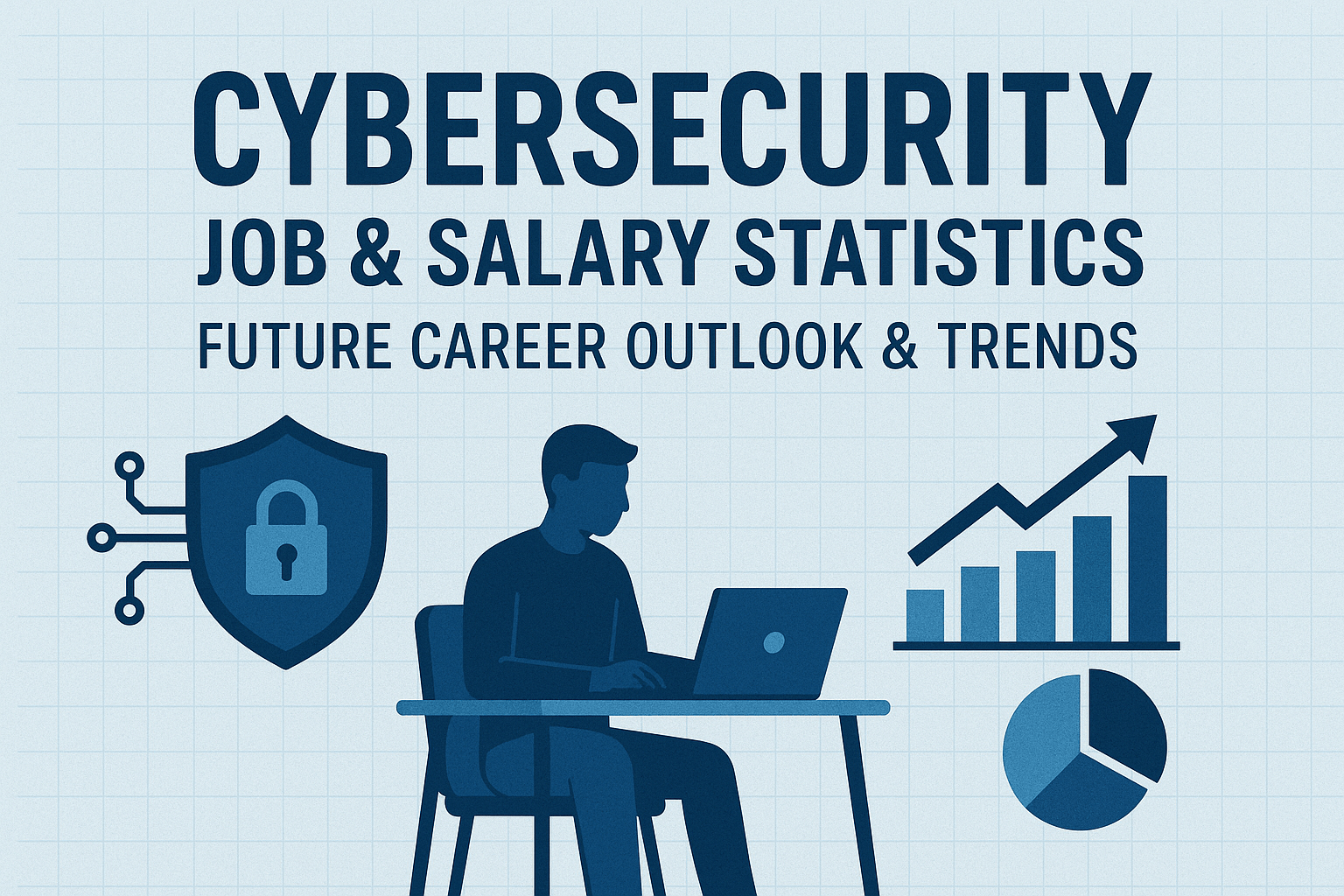The field of cybersecurity is no longer a niche IT specialty—it has become a cornerstone of global business, government operations, and even personal security. Every organization that relies on digital infrastructure, cloud computing, or customer data needs cybersecurity experts to protect against threats. As cybercrime costs continue to rise, professionals in this sector are witnessing both growing demand and highly competitive salaries.
In this article, we’ll take a deep dive into the latest cybersecurity job market statistics, the most in-demand roles, salary benchmarks across countries and industries, and how these trends are shaping the future of IT careers.
The Rising Demand for Cybersecurity Professionals
One of the biggest forces driving cybersecurity salaries upward is the massive shortage of qualified professionals. According to recent studies, there are millions of unfilled cybersecurity positions worldwide, and the number continues to grow. Organizations across every sector—from healthcare to banking—are struggling to find talent capable of defending against increasingly sophisticated cyberattacks.
The reasons behind this demand are clear. Businesses are undergoing digital transformation at a rapid pace. Cloud adoption, remote work, and AI-driven automation create new opportunities, but they also expand the attack surface for hackers. As a result, companies are pouring money into cybersecurity, making it one of the fastest-growing job markets in the world.
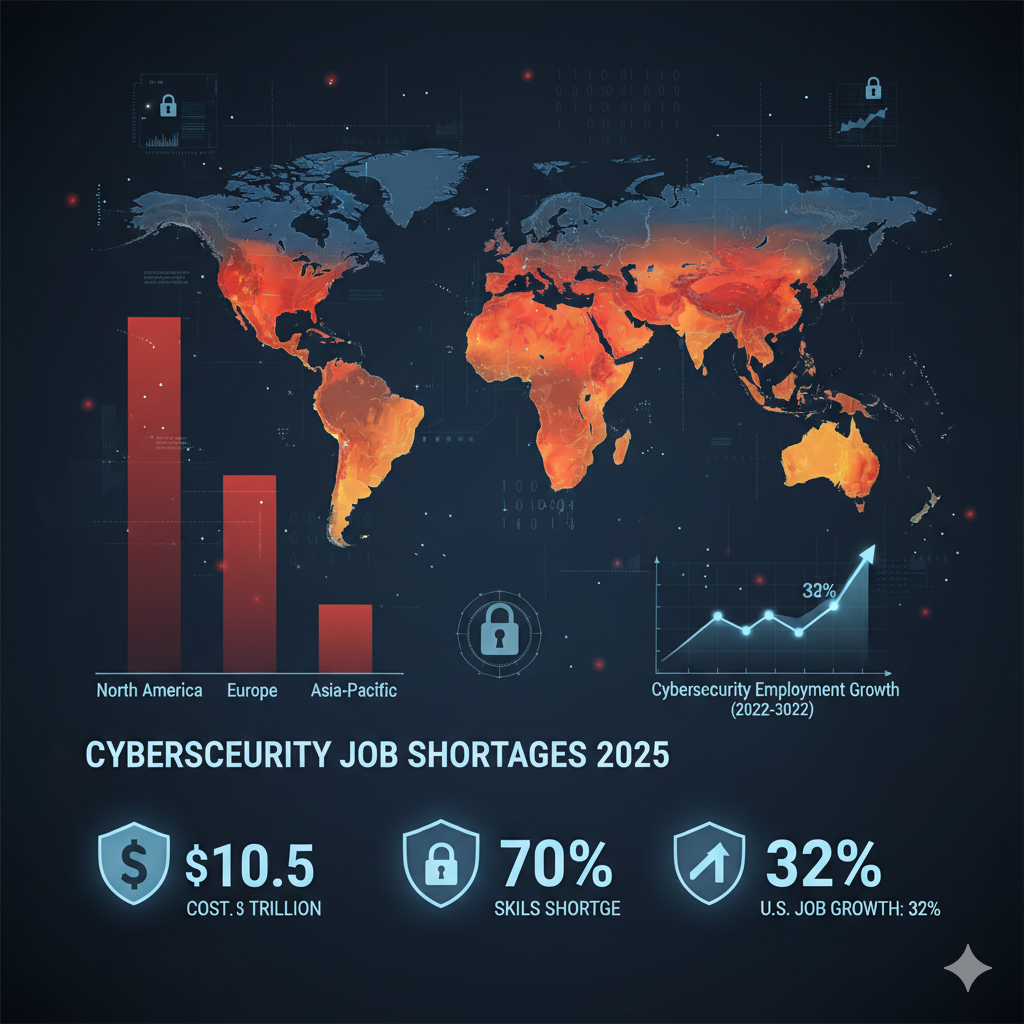
2025 Statistics to Know:
-
Cybercrime is projected to cost the global economy $10.5 trillion annually in 2025.
-
70% of organizations admit they have a skills shortage in their cybersecurity team.
-
The U.S. Bureau of Labor Statistics predicts cybersecurity employment will grow 32% between 2022 and 2032, much faster than the average for all occupations.
Popular Cybersecurity Job Roles & Average Salaries
Cybersecurity Analyst
The cybersecurity analyst role is often the starting point for many professionals entering the field. Analysts monitor security systems, investigate suspicious activities, and respond to threats before they escalate. Their day-to-day responsibilities include analyzing logs, conducting vulnerability assessments, and helping organizations stay compliant with regulations like GDPR or HIPAA.
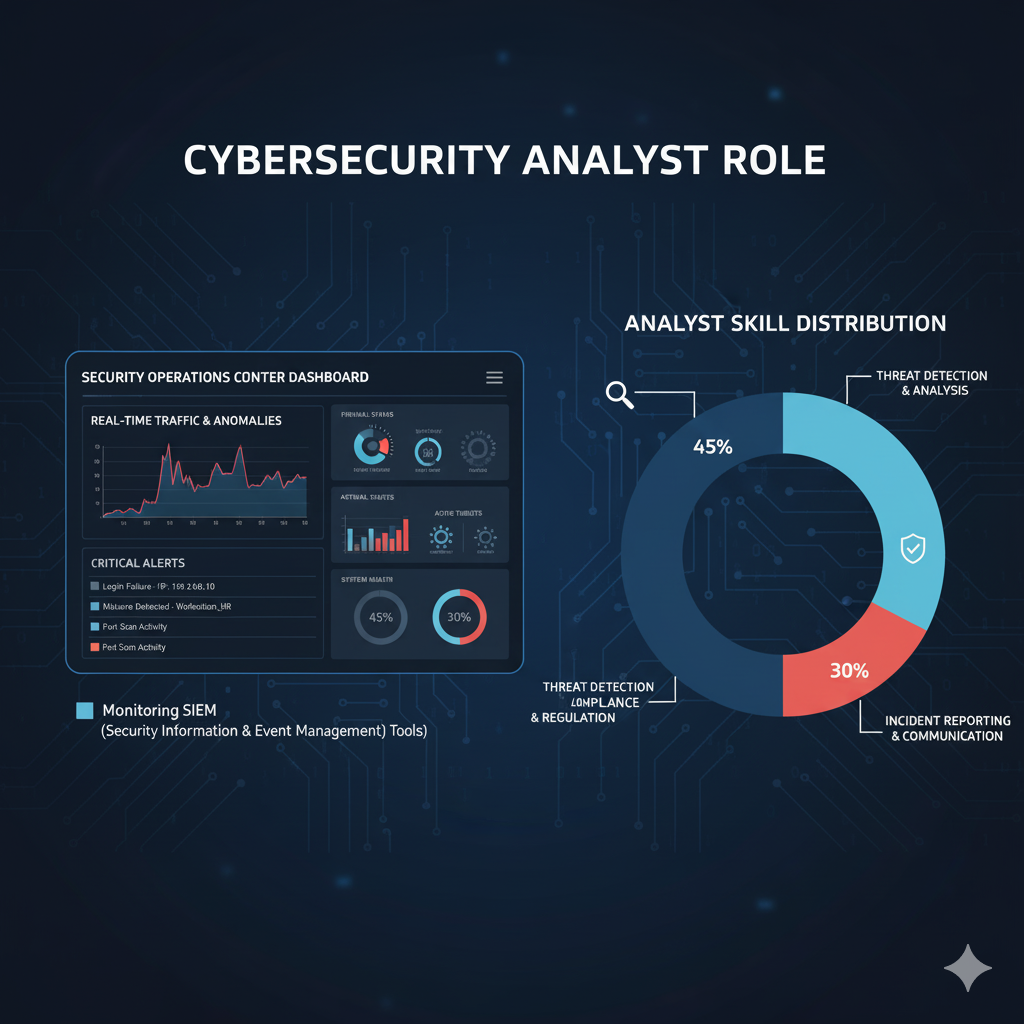
In 2025, the average salary of a cybersecurity analyst is highly competitive:
-
U.S.: $85,000 – $110,000
-
U.K.: £50,000 – £70,000
-
India: ₹8 – 15 LPA
This makes the analyst role one of the most stable and rewarding entry-level IT positions.
Penetration Tester (Ethical Hacker)
Penetration testers, also known as ethical hackers, are highly skilled professionals who simulate attacks on systems to identify vulnerabilities before malicious actors exploit them. This role requires deep technical knowledge in networking, programming, and security protocols, as well as creativity to “think like a hacker.”
Because of the critical nature of this job, salaries are strong and continue to rise:
-
U.S.: $95,000 – $120,000
-
Canada: CAD 90,000 – 115,000
-
Europe: €70,000 – €95,000
As more businesses adopt bug bounty programs and red-team testing, penetration testers remain one of the most in-demand cybersecurity roles.
Cloud Security Engineer
With cloud adoption exploding, the role of the cloud security engineer is now central to IT strategy. These experts design and implement security policies for cloud platforms like AWS, Azure, and Google Cloud. Their responsibilities include securing applications, managing access controls, and preventing data breaches in cloud-native environments.
The average salary for cloud security engineers in 2025 is impressive:
-
U.S.: $115,000 – $145,000
-
U.K.: £65,000 – £90,000
-
India: ₹15 – 25 LPA
This role combines traditional IT security skills with cloud architecture knowledge, making it one of the best-paying mid-level positions.
Security Architect
Security architects take a more strategic approach to cybersecurity. They design entire systems and frameworks to protect an organization’s infrastructure, often collaborating with developers and executives. This role requires not only technical expertise but also strong leadership and risk management skills.
Average salaries reflect the seniority of this role:
-
U.S.: $130,000 – $160,000
-
Europe: €85,000 – €120,000
As cyberattacks become more complex, the demand for architects who can build resilient systems continues to rise.
Chief Information Security Officer (CISO)
At the top of the cybersecurity career ladder is the CISO. This executive role is responsible for overall information security strategy, budget allocation, compliance, and risk mitigation at the organizational level. The CISO also reports directly to the board, making it both a technical and business-critical position.
The average CISO salary in 2025 is among the highest in IT:
-
U.S.: $180,000 – $350,000+
-
U.K.: £120,000 – £200,000
-
Global Average: Top CISOs earn $500K+ including bonuses
Salary by Industry
Not all industries pay cybersecurity professionals equally. Industries with greater exposure to sensitive data and high risk of attacks tend to offer the most competitive salaries.
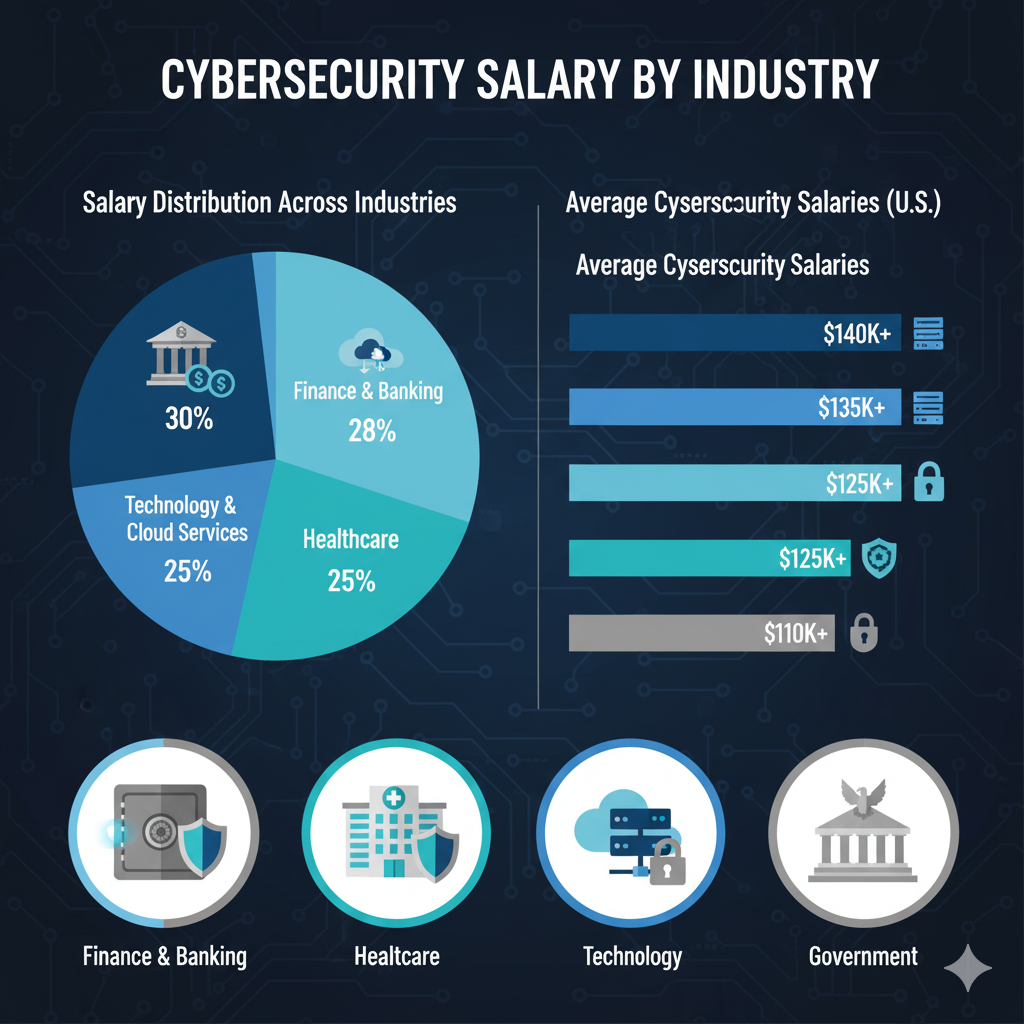
-
Finance & Banking: With sensitive customer and financial data at stake, banks are willing to pay premium salaries. Senior roles can easily exceed $140,000 annually in the U.S., with additional performance bonuses.
-
Healthcare: Ransomware attacks on hospitals and clinics have surged, forcing the healthcare industry to strengthen cybersecurity. Salaries here are rising 10–15% above IT industry averages.
-
Government & Defense: While government jobs may offer slightly lower base salaries, they provide stability, strong benefits, and bonuses for employees with security clearances.
-
Technology & Cloud Services: Tech giants and cloud providers compete fiercely for security talent, offering high salaries, stock options, and flexible perks to attract the best professionals.
Looking ahead, the cybersecurity job market is only going to expand. Emerging technologies such as AI-driven security tools, quantum computing, and zero-trust architectures are creating new challenges and opportunities. Professionals who upskill in these areas will be the highest earners of the next decade.
Moreover, compliance regulations like GDPR, HIPAA, and evolving AI safety laws will push demand for security experts who understand both technical systems and legal frameworks.
By 2030, cybersecurity is expected to be one of the top three IT career fields globally, with salaries continuing to outpace other IT disciplines.
Future Trends & Forecasts in Cybersecurity (2025–2035)
To understand where the field is headed, let’s look at major forces shaping cybersecurity’s future: market growth, talent gap, automation/AI, role evolution, risk landscapes, and skills needed.
1. Market Growth & Investment
-
The global cybersecurity market is forecast to grow significantly. One estimate puts the market at about USD 227.6 billion in 2025, rising to USD 351.9 billion by 2030, at a CAGR (Compound Annual Growth Rate) of ~9.1 %.
-
Another projection is even more aggressive: the global market may expand at a CAGR of ~12.9 % from 2025 to 2030, reaching USD 500.7 billion by 2030
-
This growth is driven by continued digital transformation, cloud adoption, IoT, stricter regulations, and rising cyber threats. The scale of investment suggests that demand for cybersecurity products and services will remain strong, which in turn fuels demand for human talent.
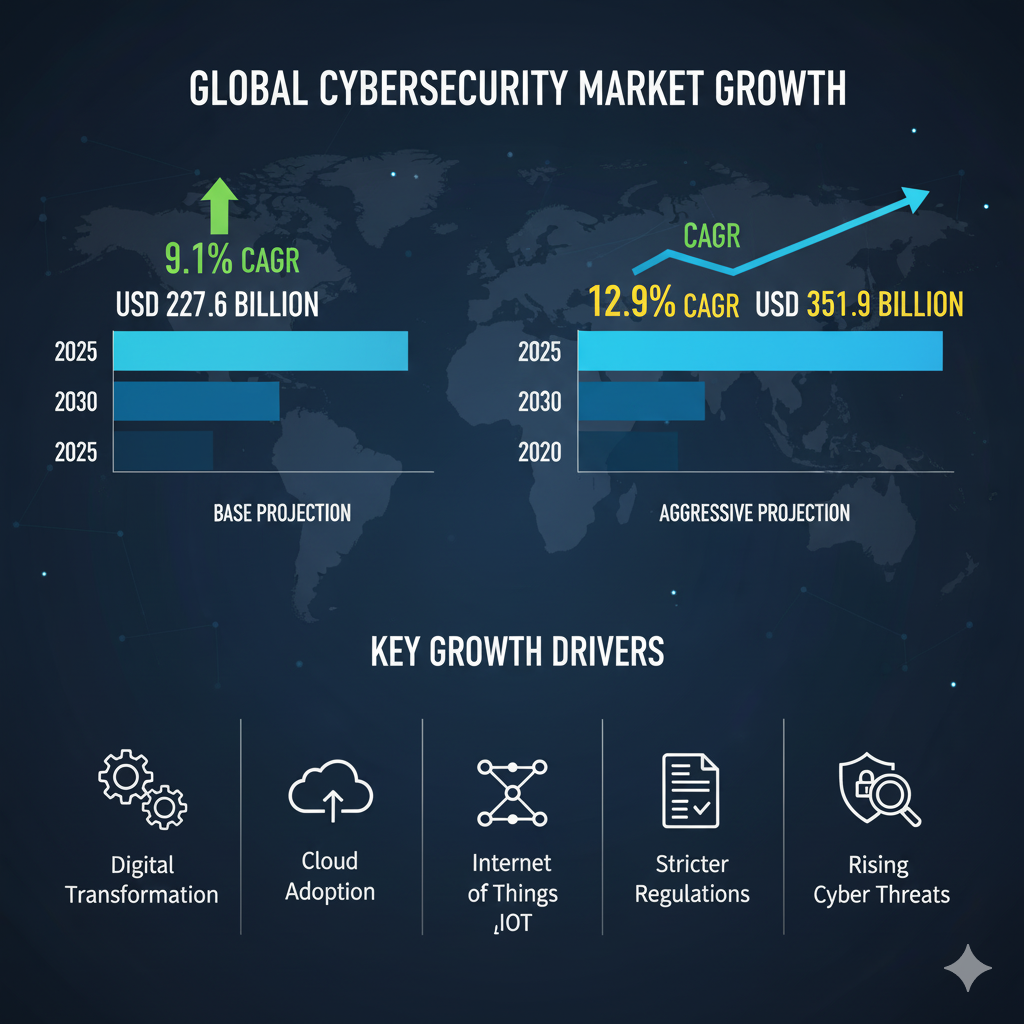
Implication for jobs & salaries: As the market grows, organizations will pour more budget into security teams, R&D, and risk mitigation. This increased funding often translates to higher salaries, more specialized roles, and greater headcount in cybersecurity.
Persistent Talent Gap & Workforce Shortage
-
Reports estimate that 4 million (or more) cybersecurity roles globally remain unfilled — indicating a huge gap between supply and demand.
-
The World Economic Forum suggests that the talent shortage across all sectors could reach 85 million workers by 2030, causing as much as USD 8.5 trillion in unrealised annual revenue globally
-
As of 2023, the cybersecurity workforce was estimated at 5.5 million globally, and it grew by ~8.7 % from 2022 to 2023 (adding ~440,000 professionals) — yet the gap kept widening.
-
In many regions (especially Asia-Pacific, Africa, Latin America), the gap is especially steep. For example, Asia-Pacific alone reportedly needs an additional ~2.6 million security professionals.
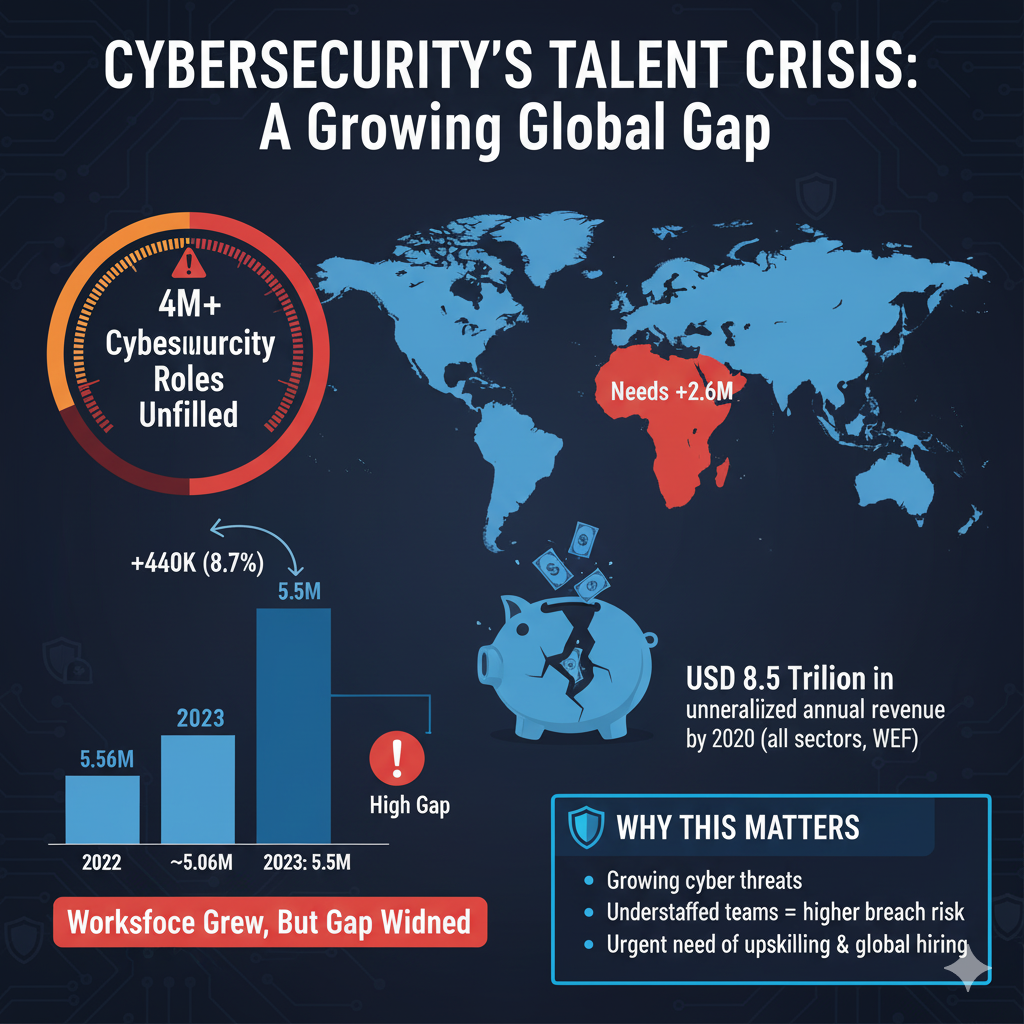
Implication: The talent shortage will continue to exert upward pressure on salaries, especially for skilled or niche roles. Organizations may compete aggressively to attract, retain, and upskill cybersecurity talent.
3. Role Evolution & Automation / AI Disruption
Automation, AI & Augmentation
-
Some routine tasks (e.g., basic alert triage, log aggregation, repetitive scanning) are increasingly being automated or assisted by AI, reducing manual workload — but not eliminating the need for human oversight.
-
Organizations are integrating AI and ML-based threat detection, anomaly spotting, and automated incident response workflows.
-
Some more “tool-centric” or lower-skill roles may shrink or evolve, while new roles centering on AI, adversarial testing, and policy oversight will grow.
Which roles may evolve or decline
-
Entry-level analyst / SOC roles: These may shift toward oversight and exception handling as automated systems handle large volumes of alerts. Some portions of these jobs could be “hollowed out.”
-
GRC (Governance, Risk, Compliance) roles: These will likely evolve into “AI-aware risk strategists” who can assess risks in AI supply chains, compliance of AI models, policy around autonomous systems
-
Pen testers / Red Teamers: Traditional tools-based testing will remain relevant, but testers will increasingly need to simulate AI-driven attacks, probe LLMs, test adversarial inputs, and evaluate model vulnerabilities.
Emerging / Future Roles (2030+)
-
AI Security Advisor / AI Model Auditor: Specialists auditing AI/ML systems for bias, poisoning, security vulnerabilities.
-
Privacy Engineer (for Generative AI and Data Pipelines): Ensuring GDPR / CCPA compliance, differential privacy, real-time anonymization in AI flows.
-
Autonomous Incident Response Architect: Designing human-in-the-loop AI systems that respond to incidents, with oversight.
-
Quantum Readiness Architect / Post-Quantum Cryptography Expert: Preparing cryptosystems and migrating systems to resist quantum decryption.
-
Ethical AI / Trust Officer roles: Overseeing trustworthy AI, ethical data usage, transparency as a security concern.
Implication: The most secure future roles will sit at the intersection of security, AI, data science, and compliance. Professionals who double-skill in AI, privacy, or emerging tech will command premium salaries.
4. Job Growth & Salary Projections
-
In the U.S., the role of Information Security Analysts is projected to grow by ~29% (2024–2034), much faster than average for other occupations.
-
Other sources estimate ~33 % growth over a decade for cybersecurity roles in the U.S.
-
According to CybersecurityEducation, the 10-year growth projection for cybersecurity roles from 2022 to 2033 is ~31.58 % (a slight downward revision from earlier projections).
-
Salary increases are also expected to continue, especially for senior and niche roles, as organizations compete for talent and invest more in security. Many industry reports suggest 4–6 % annual growth (or more) in top-tier cybersecurity compensation.
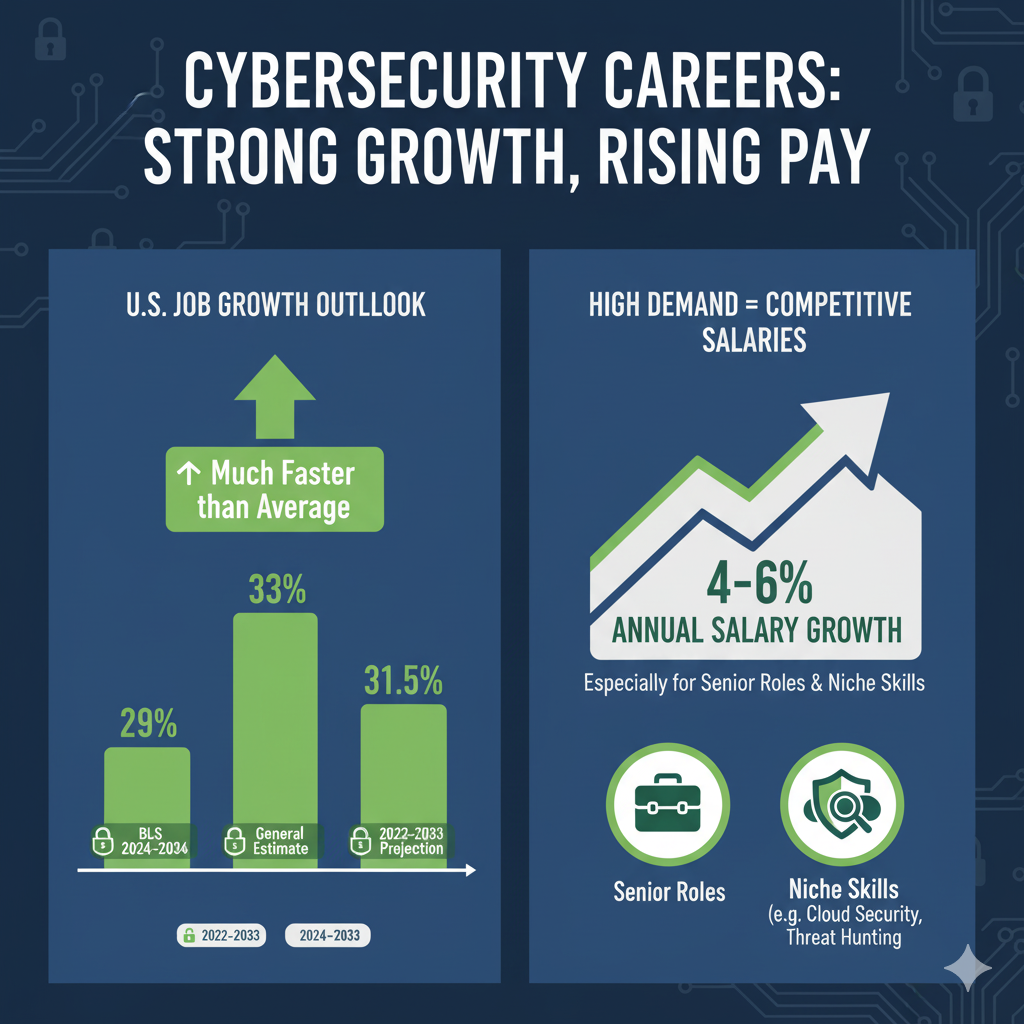
Implication: As demand outpaces supply, salaries will continue upward pressure, especially in roles requiring specialized or rare skills, leadership, or cross-domain knowledge.
5. Risk Landscape & Regulation as Drivers
-
Cyber threats are becoming more frequent, sophisticated, and damaging. As organizations face fines, reputational losses, and legal exposure, security becomes a board-level priority.
-
Regulatory pressure is increasing globally: data protection laws, AI regulations, sector-specific compliance (finance, healthcare, critical infrastructure) are pushing organizations to invest in governance, audit, and compliance-savvy security roles.
-
Emerging threats such as supply-chain attacks, cloud misconfiguration, ransomware, zero-day exploits, AI-based attacks, and quantum decryption risks will demand advanced expertise.
-
The convergence of security with privacy, AI ethics, trust, and transparency means roles will no longer be purely technical—they must navigate policy, law, and public perception.
Implication: Security talent that also understands regulation, ethics, and business risk will be especially valuable and well-paid.
6. Skills, Education & Career Strategy for the Next Decade
To thrive in the future cybersecurity landscape, you’ll want to align with where demand is heading:
In-Demand Skills & Domains
-
AI / ML security: Understanding model vulnerabilities, adversarial inputs, model governance.
-
Cloud-native security & DevSecOps: Security-as-code, Kubernetes, containers, IaC, serverless architecture.
-
Zero-trust & identity security: Microsegmentation, identity governance, policy-based access.
-
Privacy & data protection: Differential privacy, privacy engineering, data anonymization.
-
Post-quantum cryptography: Key exchange algorithms and migration strategies.
-
Incident automation & SOAR / autonomous response: Building systems that take intelligent action under oversight.
-
Cross-disciplinary skills: Legal / compliance, ethics, risk analysis, communication, leadership.
Education & Hiring Shifts
-
Employers will increasingly value skills over credentials. A study showed AI/green job postings are shifting from degree requirements to skill-based hiring, and the “premium” for skills is growing.
-
Microcredentials, bootcamps, labs, and hands-on project experience will carry more weight.
-
Continuous learning becomes a necessity; certifications must evolve (future AI/security certs, quantum crypto, etc.).
-
Interdisciplinary exposure (working with data scientists, legal/compliance teams, product managers) will help professionals stay relevant.
Strategic Career Moves
-
Map which parts of your role are most likely to be automated; pivot your focus to tasks that require intuition, creativity, or cross-domain judgment.
-
Start blending in adjacent skills (AI, privacy, compliance, risk).
-
Work on visible projects, open source, or publish/write about your approaches to demonstrate thought leadership.
-
Network beyond security — connect with legal, product, data, and AI teams to broaden perspective.
-
Target future-forward roles early (AI security, cloud-native architecture, adversarial testing).
The Future of Cybersecurity Jobs: 2025–2035
Skyrocketing Market & Investment
The cybersecurity industry is on track for explosive growth. From an estimated USD 227.6 billion in 2025, it may expand to USD 351.9 billion by 2030 (CAGR ~9.1 %) and potentially reach over USD 500 billion under more aggressive forecasts (CAGR ~12.9 %). This expansion reflects the rising stakes of digital transformation, cloud adoption, and evolving threat landscapes.
Talent Gap That Won’t Close
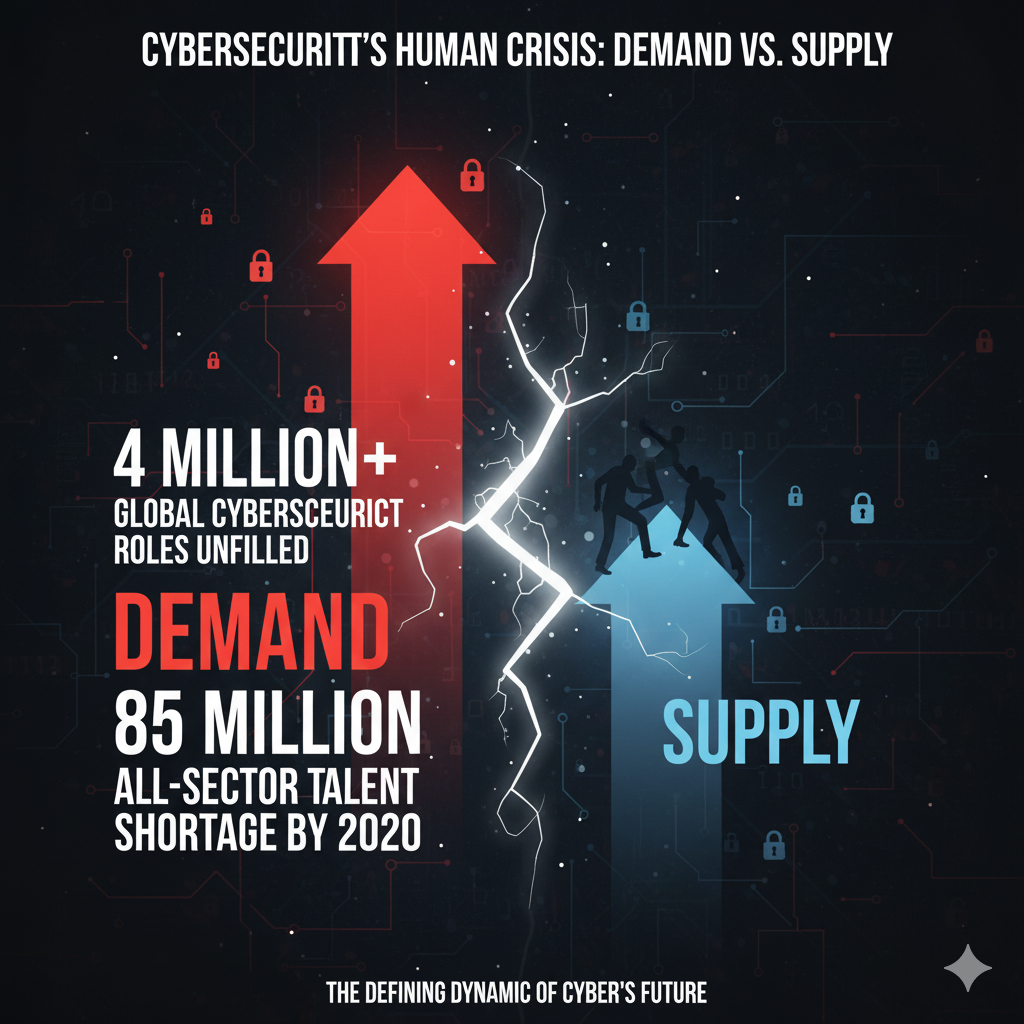
Despite growth, the human side is lagging. A global shortfall of 4 million+ cybersecurity professionals is frequently cited, and this gap might balloon to 85 million when considering all sectors by 2030. The mismatch between demand and supply is one of the defining dynamics of cybersecurity’s future.
Roles in Flux: What Evolves, What Emerges
Routine or tool-driven tasks will increasingly be handled by automation or AI, pushing human professionals toward oversight, exception handling, and orchestration.Meanwhile, new roles will emerge at the intersections of AI, privacy, and security:
-
AI Security Advisors / Model Auditors
-
Quantum Readiness & Post-Quantum Cryptography Experts
-
Autonomous Incident Response Engineers
-
Ethical AI / Trust Officers
Growth & Compensation Trajectory
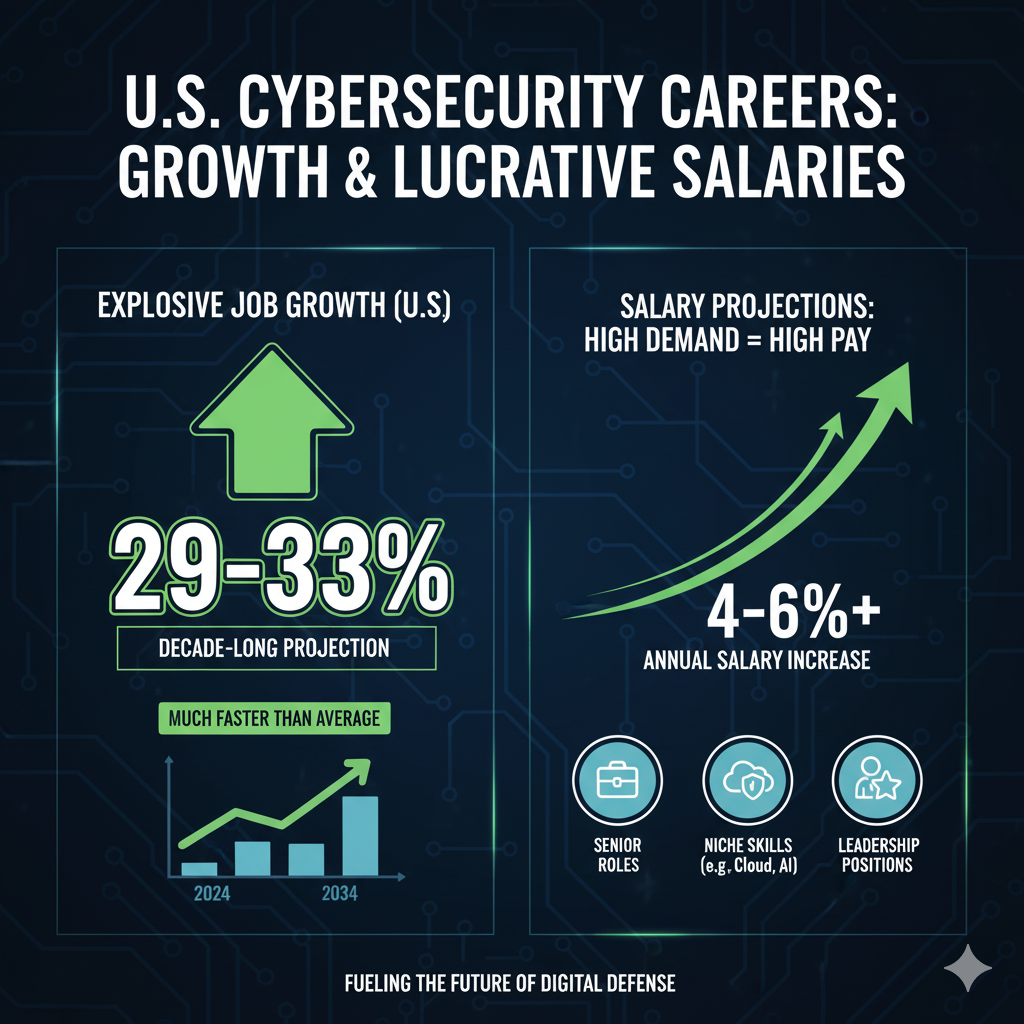
In the U.S., information security analyst roles are expected to grow ~29–33 % over a decade. Given the talent crunch, salaries—especially for senior, niche, or leadership roles—will continue climbing. Many projections show 4–6 % (or more) yearly increases in compensation, particularly where roles require advanced skills or cross-domain knowledge.
Risk, Regulation & Technology as Catalysts
Security is no longer just about breaches—it’s about trust, compliance, and brand survival. As AI regulation, cloud standards, and industry-specific compliance tighten, the demand for professionals who speak both technology and policy languages will grow. Emerging threats — AI-powered attacks, supply-chain risk, quantum threats — will demand cutting-edge responses.
Conclusion
Cybersecurity is not just a job—it’s a career path that offers stability, growth, and high earning potential. From analysts to CISOs, professionals in this field are in high demand worldwide. For anyone considering a future-proof career, cybersecurity offers not only financial rewards but also the opportunity to protect organizations and society from ever-evolving digital threats.
👉 If you’re planning to start or advance in cybersecurity, now is the best time to invest in certifications, hands-on experience, and specialization in high-demand areas like cloud and AI security.
FAQs
Q1. Is cybersecurity a high-paying career in 2025?
Yes. Cybersecurity remains one of the highest-paying IT career paths. Entry-level analysts earn around $85,000–$110,000 in the U.S., while CISOs can command salaries of $180,000–$350,000+, with some exceeding $500K when bonuses and incentives are included.
Q2. Which cybersecurity jobs have the highest salaries?
Senior leadership and specialized roles such as CISO (Chief Information Security Officer), Security Architect, Cloud Security Engineer, and Penetration Tester rank among the highest-paying jobs in cybersecurity.
Q3. What industries pay the most for cybersecurity professionals?
Banking & finance, healthcare, government & defense, and technology/cloud services are top-paying industries. Finance and healthcare, in particular, pay a premium due to the sensitivity of the data they handle.
Q4. What skills will future cybersecurity jobs require?
Emerging roles will demand expertise in AI/ML security, cloud-native security, privacy engineering, zero-trust architecture, and post-quantum cryptography. Knowledge of compliance, risk management, and AI governance will also be highly valued.
Q5. Is the demand for cybersecurity professionals growing?
Absolutely. The global cybersecurity workforce still faces a shortage of more than 4 million professionals. Employment for security analysts is projected to grow 29–33% in the next decade, far outpacing the average for other jobs.
Q6. How can I increase my cybersecurity salary?
Gaining specialized certifications (like CISSP, CEH, CISM, or cloud-specific credentials), developing cross-disciplinary expertise (AI, compliance, privacy), and moving into leadership or niche roles are proven ways to boost earning potential.
Reference
MarketsandMarkets – Cybersecurity Market Size & Growth Forecast (2025–2030)
Grand View Research – Cybersecurity Market Growth Report 2025–2030
World Economic Forum – Cybersecurity Industry Talent Shortage Report
World Economic Forum – Global Workforce Shortage Projections (2030)
StationX – Cybersecurity Job Statistics (2023–2025)
U.S. Bureau of Labor Statistics – Information Security Analyst Job Outlook
Coursera – Cybersecurity Trends & Future Outlook
CybersecurityEducation.org – Salary & Job Growth Projections
Dev.to – The Future of Cybersecurity Jobs: What’s Thriving, Evolving, and Disappearing by 2030
Arxiv – Shifts Toward Skill-Based Hiring in Tech (AI & Green Jobs)

